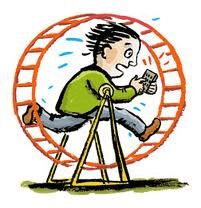
As one of our clients likes to remind us, “the world spins so fast!” It’s true that life moves so quickly that it oftentimes feels we are barely keeping up, if at all. If you feel this way, you are not alone.
In addition to drowning in overwhelm, there is another growing problem: not having any time to process what is happening in our lives. Wake up, jump on the hamster wheel, go to bed, repeat. That furious cycle may sound very familiar. The challenge with such repetition (other than pure exhaustion and burnout) is that there isn’t an opportunity for perspective. It’s hard to see where we’ve been or where we are headed if we cannot get off of the spinning wheel of life once in a while to be still and contemplate.
Stillness is a cornerstone of stoicism, eastern philosophies, and even the more modern focus on mindfulness and meditation. Indeed even the U.S. Army practices a form of stillness and contemplation in a method they call an “after-action review.”
Studies into these practices reveal the power and clarity that deep thought unlocks. The art of still doing not involve waxing nostalgic or being melancholy over time gone by (although these are valid feelings that may creep in sometimes). Instead stillness, meditation, and “after-action reviews” all center around allowing our thoughts to be freed from the mental blockade our subconscious brains adopt in the daily survival mode necessary to react to the ferocity of data inputs and stimulus the hamster wheel brings. It’s essential to our well-being, personal growth, and longevity to review what has happened. We need to process what we’ve learned from our experiences and how we can improve. Of course, this is impossible in real-time with all of our daily distractions and things fighting for our attention.
The good news is that it is not very hard to achieve the clarity stillness brings. You don’t have to sit in a pretzel formation like a seasoned yogi for hours and levitation is certainly not required. All that needs to happen is for you to take a short pause and enjoy the silence around you. Even small moments on a daily basis will open your mind to positive thoughts which will bring clarity.
That clarity comes once the floodgate of thoughts are released. It may seem counterintuitive that to quiet the mind you will need to experience a flood of thoughts. But instead of having zero thought, what we are really trying to achieve is to remove the mental logjam that our survival mode brain constructs. We jokingly call this “mental constipation” Our mental stress will experience relief as these pent-up thoughts are no longer subconsciously clamoring to be heard. That quiet in their absence is the comfort we seek and allows an open space in our minds for peace, creativity, and wonderful “ah-ha” moments.
If this all sounds a little “woo-woo” to you, we understand. It did for us originally, too. However, think about the last time you had a great idea. What were you doing? Many great ideas come to us in the shower or while exercising on a walk, run, or bike ride. That’s because we are focusing on something different than the hamster wheel. Stillness doesn’t necessarily mean inaction, but rather the stillness of the mind. This can be achieved while focusing on a singular action or anything that requires you to get off the hamster wheel to do. That’s why the revered Buddhist monk, Thich Nhat Hahn, often finds clarity while washing the dishes.
For more great reading on the power of stillness, we recommend “Stillness Is the Key” by Ryan Holiday (you can find it in your local library or on Amazon). It’s revolutionized how we approach our lives and has made an especially huge difference in the chaos of the pandemic. Whether you read the book or not, we hope a little more stillness in your days does the same for you.
